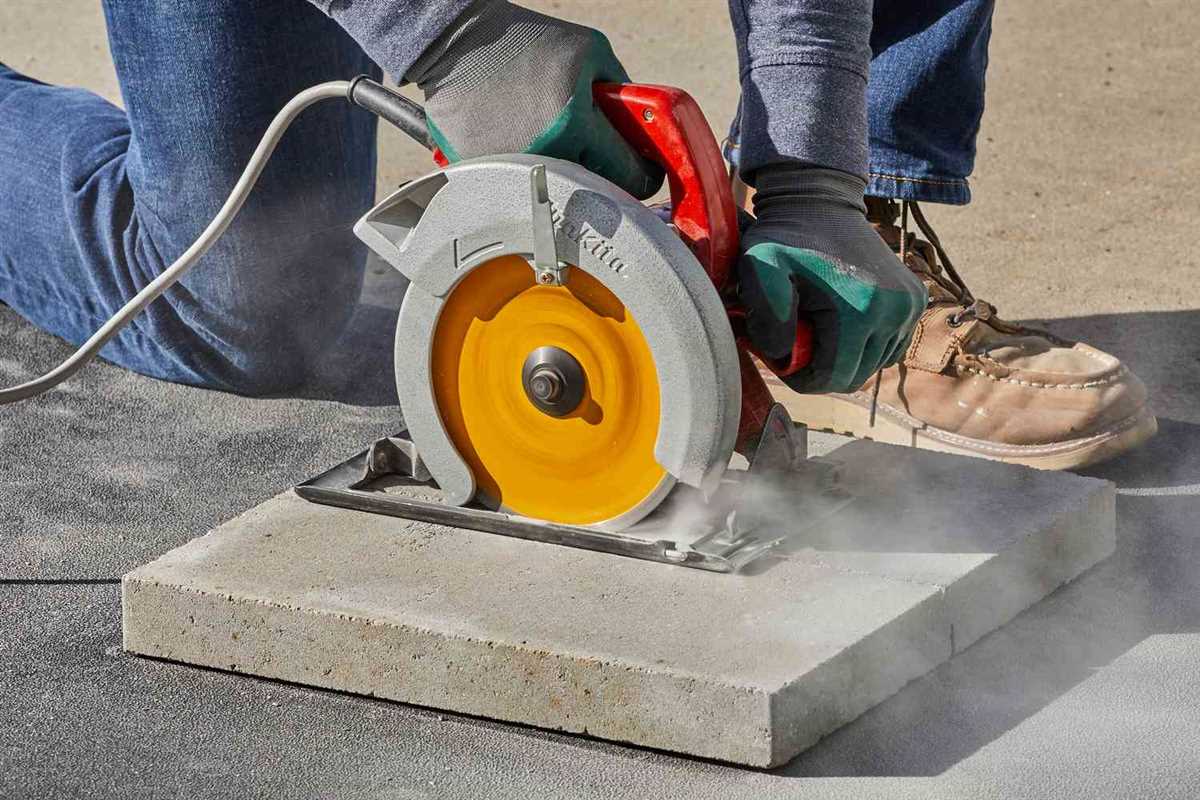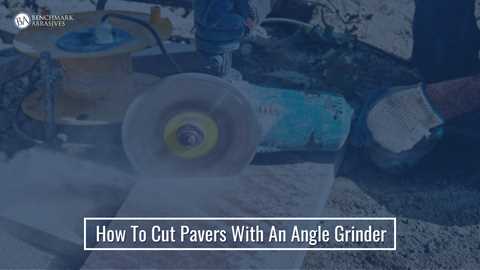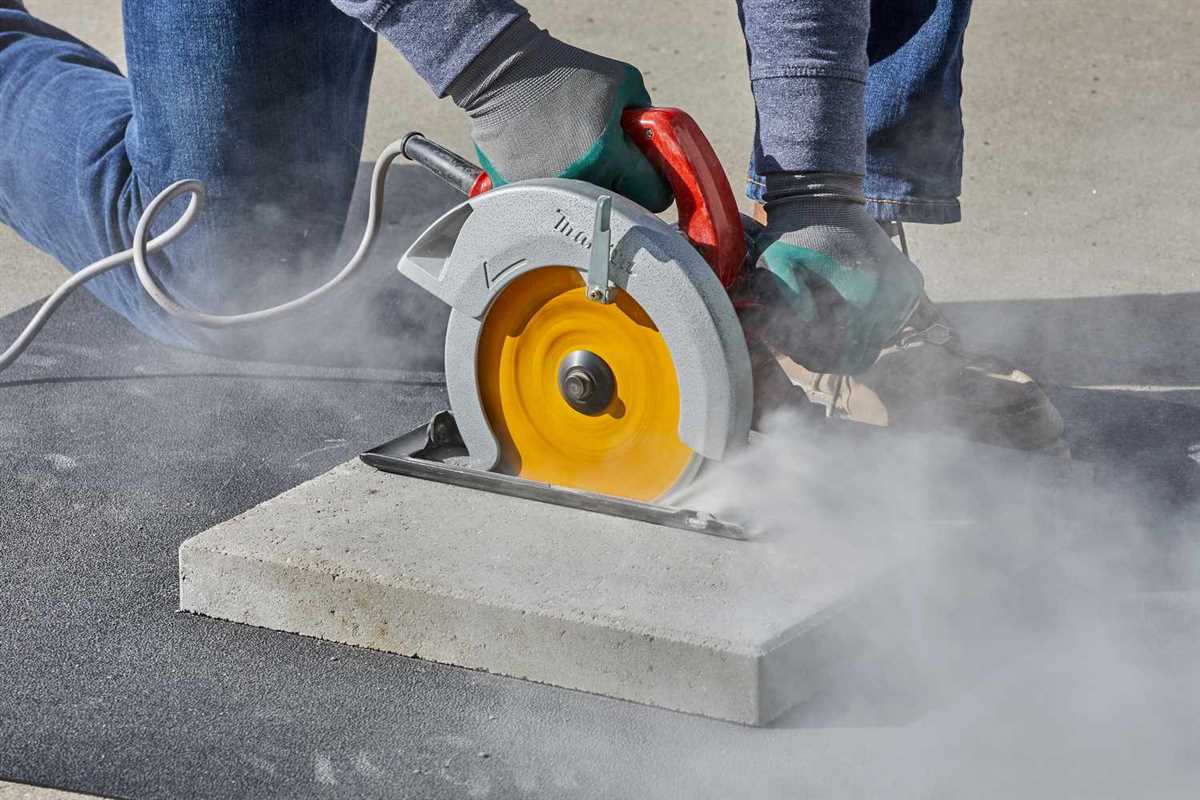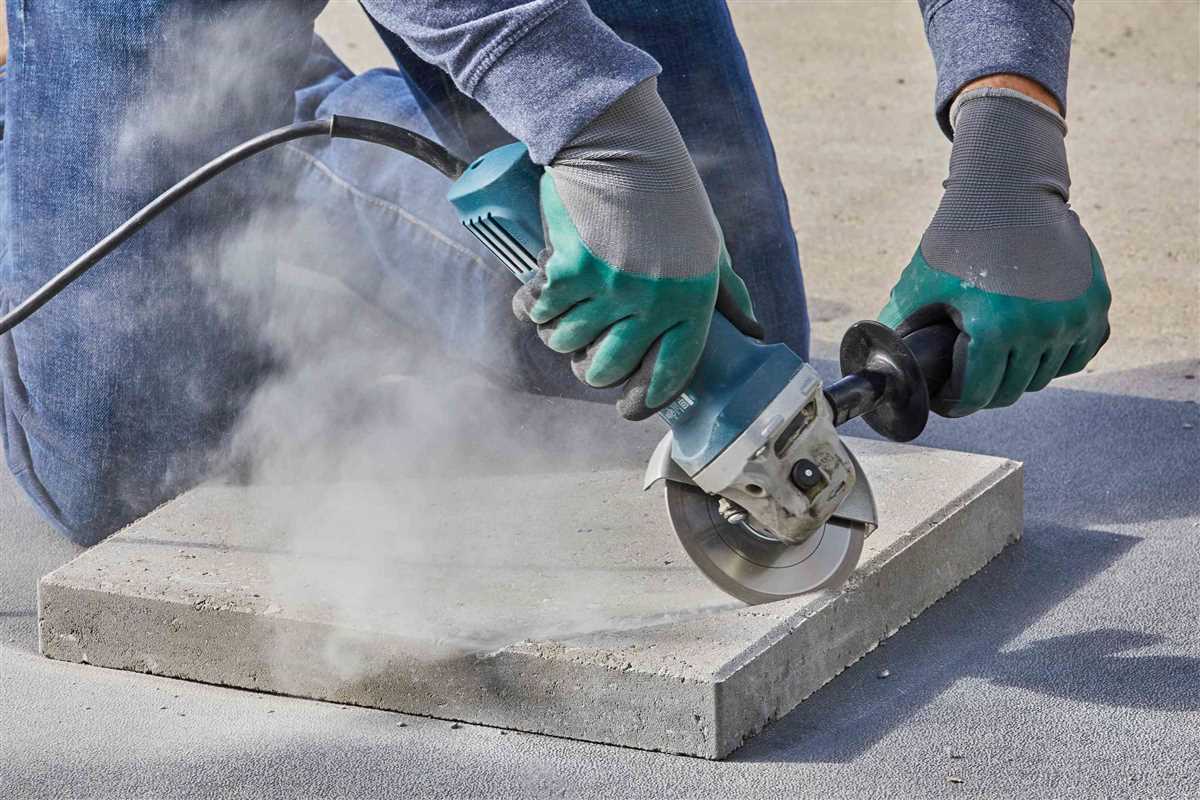Learn the Best Way to Cut Pavers with an Angle Grinder

When it comes to cutting pavers, using an angle grinder can be a game-changer. This versatile tool is perfect for creating clean, precise cuts in a variety of materials, including concrete, stone, and porcelain. Whether you’re a seasoned DIY enthusiast or a professional contractor, learning how to properly use an angle grinder for cutting pavers can save you time and effort on your next project.
One of the main advantages of using an angle grinder is its ability to make straight cuts with ease. Unlike other cutting tools, an angle grinder allows you to adjust the cutting depth and angle, giving you more control over the final result. This means you can create cuts that fit perfectly into your project, whether it’s a patio, driveway, or garden pathway.
Another benefit of using an angle grinder for cutting pavers is the speed and efficiency it offers. With the right blade, an angle grinder can quickly and effortlessly cut through even the toughest materials. This makes it an ideal tool for large-scale projects where time is of the essence, as well as smaller DIY jobs that require precision and accuracy.
The Importance of Cutting Pavers Correctly
Ensuring a proper fit
When it comes to paving projects, one of the most important aspects is the precision in cutting the pavers. Whether you are creating a patio, walkway, or driveway, it is crucial that the paver pieces fit together seamlessly. Cutting pavers correctly ensures that the edges align perfectly, resulting in a professional-looking finished project.
Maintaining structural integrity
Another reason why cutting pavers correctly is essential is to maintain the structural integrity of the project. Pavers are designed to provide a durable and long-lasting surface, but improper cuts can weaken their stability. If the cuts are not clean and accurate, the pavers may not lock together securely, leading to potential shifting, cracking, or even collapse over time.
Minimizing material waste
Efficiently cutting pavers also helps to minimize material waste. Pavers can be quite expensive, so making precise cuts allows you to make the most of the available materials. By using an angle grinder and following proper techniques, you can ensure that you achieve the desired shapes and sizes without excess waste, ultimately saving money and reducing environmental impact.
Enhancing safety
Cutting pavers correctly not only contributes to the aesthetic and structural aspects of the project but also enhances safety. A poorly cut paver may have sharp or uneven edges that can pose a tripping hazard. Additionally, improper cuts can result in pieces that do not fit securely, increasing the risk of accidents and injuries. By taking the time to cut pavers accurately, you can ensure a safer environment for both yourself and others.
In conclusion, the importance of cutting pavers correctly cannot be overstated. It ensures a proper fit, maintains structural integrity, minimizes material waste, and enhances safety. So, if you are planning a paving project, take the time to learn the best way to cut pavers with an angle grinder and achieve professional-looking, long-lasting results.
Understanding the Different Types of Pavers
Pavers are a popular choice for outdoor hardscape projects due to their durability, versatility, and aesthetic appeal. There are various types of pavers available on the market, each with its own unique characteristics and benefits. Understanding the different types of pavers can help you make an informed decision when choosing the right option for your project.
1. Concrete Pavers

Concrete pavers are a versatile option that can be used for various outdoor applications, such as patios, driveways, and walkways. They are made from a mixture of cement, aggregate, and coloring agents, which creates a strong and durable surface. Concrete pavers come in a wide range of sizes, shapes, and colors, allowing for endless design possibilities.
2. Brick Pavers
Brick pavers are a classic choice that adds a timeless charm to any outdoor space. They are made from clay or concrete and are known for their strength and durability. Brick pavers are available in various patterns, such as herringbone, basket weave, and running bond, allowing for unique and intricate designs.
3. Natural Stone Pavers
Natural stone pavers offer a luxurious and elegant look to any outdoor area. They are available in different types of stone, including limestone, granite, sandstone, and slate, each with its own distinct colors and textures. Natural stone pavers are known for their durability, long lifespan, and natural beauty.
4. Rubber Pavers
Rubber pavers are a popular choice for playgrounds, fitness areas, and other high-impact spaces. They are made from recycled rubber and offer excellent shock absorption and slip resistance. Rubber pavers are also eco-friendly and low-maintenance, making them a sustainable option.
5. Permeable Pavers
Permeable pavers are designed to allow water to flow through them, preventing the buildup of puddles and reducing runoff. They are typically made from concrete or clay and feature open-joint designs or porous surfaces. Permeable pavers are an eco-friendly option that helps manage stormwater and promote groundwater recharge.
When choosing pavers for your project, consider factors such as your desired aesthetic, budget, maintenance requirements, and the specific needs of your outdoor space. It’s also important to consult with a professional to ensure the proper installation and longevity of your pavers.
Choosing the Right Angle Grinder for the Job
When it comes to cutting pavers with an angle grinder, choosing the right tool for the job is essential. There are several factors to consider when selecting an angle grinder that will meet your needs.
Power: The power of the angle grinder is crucial in determining its effectiveness in cutting through pavers. Look for a grinder with a high wattage rating, as this indicates the grinder’s ability to handle tough materials like concrete or stone.
Size: The size of the grinder is another important factor to consider. A smaller grinder may be more maneuverable and easier to handle, but it may not have the power needed to cut through thick pavers. On the other hand, a larger grinder may be able to handle heavier tasks but may be more difficult to control. Consider the size of the pavers you will be cutting and choose a grinder that is suitable for the job.
Disc Type: The type of disc that comes with the grinder is also important. There are two common types of discs used for cutting pavers: diamond blades and abrasive blades. Diamond blades are durable and provide clean cuts, making them ideal for cutting through hard materials. Abrasive blades, on the other hand, are cheaper but may wear out quickly, especially when cutting through tough surfaces like concrete. Choose the disc type that matches your cutting needs.
Speed: The speed of the grinder is measured in rotations per minute (RPM). Higher RPMs generally result in faster cutting, but they may also increase the risk of accidents if not properly controlled. Consider the intended use of the grinder and choose a speed that is suitable for the task at hand.
Safety Features: Lastly, don’t forget to consider the safety features of the angle grinder. Look for grinders with features like a safety switch, a guard that covers the disc, and a handle that provides a secure grip. These features will help ensure your safety while using the grinder.
In conclusion, choosing the right angle grinder for cutting pavers is essential for achieving clean and precise cuts. Consider factors like power, size, disc type, speed, and safety features when selecting a grinder that will meet your needs. By making an informed decision, you can ensure efficient and safe cutting of pavers with an angle grinder.
Safety Precautions to Take Before Cutting Pavers
Before using an angle grinder to cut pavers, it is essential to take certain safety precautions to ensure that you and those around you are protected. Here are some important measures to consider:
- Wear protective gear: Prior to starting the cutting process, make sure to wear appropriate safety gear, such as safety goggles, gloves, and ear protection. This will shield you from any potential debris or sparks that may be produced during the cutting.
- Select a suitable work area: Choose a well-ventilated and spacious work area where you can freely maneuver the angle grinder. Ensure that there are no flammable materials nearby and that the space is clear of obstructions.
- Secure the pavers: Before cutting, it is crucial to properly secure the pavers. Place them on a firm and stable surface, such as a workbench or sawhorse, to prevent them from moving or falling during the cutting process.
- Inspect the angle grinder: Thoroughly inspect the angle grinder for any damages or defects before use. Check the power cord for cuts or frays and ensure that the guards and safety features are in place and functioning correctly.
- Follow manufacturer’s instructions: Always refer to the manufacturer’s instructions and guidelines when operating the angle grinder. Familiarize yourself with the tool’s features and operation, including the proper way to hold and control it.
- Use the right blade: Select a diamond or masonry blade that is suitable for cutting pavers. Using the wrong type of blade can lead to inefficient cutting or even damage to the angle grinder.
- Maintain a safe distance: When cutting pavers, it is crucial to maintain a safe distance from others, especially if you are working in a shared space. This will reduce the risk of accidents and injuries.
- Take breaks: Cutting pavers can be a physically demanding task, so remember to take regular breaks to prevent fatigue. This will help you stay focused and maintain control over the angle grinder.
By following these safety precautions, you can minimize the risk of accidents and ensure a safe cutting process when using an angle grinder to cut pavers.
Step-by-Step Guide on How to Cut Pavers with an Angle Grinder
1. Prepare the necessary equipment
Before you begin cutting pavers with an angle grinder, gather all the necessary equipment. This includes a quality angle grinder, a diamond blade suitable for cutting pavers, safety goggles, hearing protection, and gloves. Make sure you have a stable work surface and clear the area of any obstructions.
2. Measure and mark the paver
Take a measuring tape and determine the exact length or shape you need to cut the paver into. Use a pencil or chalk to mark the cut line on the paver. Double-check your measurements to ensure accuracy.
3. Secure the paver


Place the paver on a stable surface, such as a workbench or a piece of plywood. Use clamps or a vice to secure the paver in place, ensuring it doesn’t move during the cutting process.
4. Put on safety gear
Prior to starting the angle grinder, put on your safety goggles, hearing protection, and gloves to protect yourself from flying debris and potential hazards.
5. Cut the paver
Hold the angle grinder firmly with both hands and position the diamond blade perpendicular to the marked line on the paver. Slowly lower the blade onto the paver and begin cutting along the marked line. Apply even pressure and let the grinder do the work, avoiding excessive force that may cause the blade to bind or kickback.
6. Check the cut
Once you have completed the cut, turn off the angle grinder and inspect the paver to ensure the cut is clean and accurate. If needed, use a file or sandpaper to smooth out any rough edges.
7. Continue cutting
If you need to cut multiple pavers, repeat steps 2-6 for each individual paver. Take breaks as needed to rest and avoid fatigue, but always remember to prioritize safety.
8. Clean up the work area
When you have finished cutting all the pavers, clean up the work area by removing any debris and storing the angle grinder and other equipment properly. Dispose of any waste materials according to local regulations.
Cutting pavers with an angle grinder can be a precise task if done correctly. Follow this step-by-step guide to ensure a clean and accurate cut every time, while prioritizing your safety throughout the process.
Tips and Tricks for a Clean and Precise Cut

1. Choose the right blade
When using an angle grinder to cut pavers, it’s important to select the right blade for the job. A diamond blade is the most suitable choice, as it is designed specifically for cutting hard materials like concrete and stone. Make sure the blade is compatible with your angle grinder, and always check for any signs of damage before starting your project.
2. Mark your cutting line
Before making any cuts, take the time to mark your cutting line on the paver. This will help you achieve a clean and precise cut. Use a straightedge or ruler to draw a straight line along the surface of the paver, and make sure the line is clearly visible.
3. Secure the paver
It’s important to secure the paver in place before starting the cutting process. This will help prevent any movement or shifting that could lead to an inaccurate cut. You can use clamps or a vice to hold the paver firmly in place, ensuring it remains stable throughout the cutting process.
4. Take your time
When cutting pavers with an angle grinder, it’s crucial to work slowly and carefully. Rushing the process can result in a less precise cut and increase the risk of accidents. Take your time and maintain a steady hand, allowing the blade to do the work for you.
5. Use proper safety gear
Whenever working with power tools, it’s essential to prioritize safety. When cutting pavers with an angle grinder, make sure to wear appropriate safety gear such as safety glasses, gloves, and ear protection. This will help protect you from any potential injuries or hazards.
By following these tips and tricks, you can achieve a clean and precise cut when using an angle grinder to cut pavers. Remember to always exercise caution and take the necessary safety precautions throughout the process.
Common Mistakes to Avoid When Cutting Pavers
1. Lack of Safety Precautions
One of the most common mistakes made when cutting pavers is failing to take proper safety precautions. It’s important to wear protective gear such as goggles, gloves, and a dust mask to protect yourself from potential hazards. Additionally, make sure to keep bystanders at a safe distance and secure the paver firmly before cutting.
2. Using the Wrong Blade
Using the wrong blade for cutting pavers is another common mistake that can lead to a subpar result. Make sure to choose a blade specifically designed for cutting pavers or masonry. Using a blade designed for other materials may not cut through the paver effectively and can result in a jagged or uneven cut.
3. Incorrect Cutting Technique
Having an incorrect cutting technique can also lead to mistakes when cutting pavers. It’s important to start the cut with a shallow depth and gradually increase it to avoid overloading the blade. Additionally, maintain a steady and consistent cutting speed to achieve a clean and accurate cut. Avoid applying excessive force or tilting the grinder while cutting to prevent errors.
4. Ignoring the Importance of Marking
Marking the paver before cutting is crucial for achieving precise cuts, but it’s a mistake that many people overlook. Use a pencil or chalk to mark the desired cut line on the paver and ensure it’s straight and accurate. This will serve as a guide for your cutting process and help prevent any errors or inconsistencies.
5. Rushing the Cutting Process
Rushing the cutting process is a common mistake that can result in poor-quality cuts. Take your time and work at a steady pace to ensure accuracy and precision. Trying to cut too quickly may cause the blade to become overheated, resulting in a damaged or worn-out blade. It’s better to prioritize quality over speed when cutting pavers with an angle grinder.
In conclusion, by avoiding these common mistakes, you can ensure a smoother and more successful cutting process when working with pavers. Taking the time to properly prepare, choose the right tools, and use the correct technique will result in clean and accurate cuts for your paver projects.
Finishing Touches: Sealing and Installing the Cut Pavers
Sealing the Cut Pavers
After cutting the pavers with an angle grinder, it is important to seal them to protect them from moisture, stains, and other types of damage. Sealing the cut pavers will help to enhance their durability and prolong their lifespan. There are various types of sealers available, including acrylic sealers, polyurethane sealers, and solvent-based sealers. Before applying the sealer, make sure the cut pavers are clean and dry. Follow the manufacturer’s instructions for applying the sealer, and apply it evenly using a roller or a brush. Allow the sealer to cure according to the recommended time frame before using the pavers.
Installing the Cut Pavers
Once the cut pavers are sealed and cured, they are ready to be installed. Start by preparing the area where the pavers will be installed, ensuring it is clean, level, and compacted. Lay a layer of base material, such as gravel or sand, to create a stable foundation for the pavers. Use a level and a string line to ensure the base is even and level. Place the cut pavers onto the base, leaving a uniform gap between each paver for jointing sand. Use a rubber mallet or a block of wood to tap the pavers into place, making sure they are level and aligned. Once all the pavers are installed, sweep jointing sand into the gaps and compact it using a broom or plate compactor. This will help to stabilize the pavers and prevent weed growth.
FAQ:
What is the best tool to use when cutting pavers?
The best tool to use when cutting pavers is an angle grinder.
Can I use a regular saw instead of an angle grinder to cut pavers?
While it is possible to use a regular saw to cut pavers, an angle grinder is often a better choice because it provides more control and precision.
How do I choose the right blade for cutting pavers with an angle grinder?
When choosing a blade for cutting pavers with an angle grinder, it is important to look for one specifically designed for masonry. The blade should have diamond segments for improved cutting performance.
Is it difficult to cut pavers with an angle grinder?
Cutting pavers with an angle grinder can be a bit challenging, especially if you are not familiar with using power tools. However, with proper technique and safety precautions, it can be done successfully.
Are there any safety precautions I should take when cutting pavers with an angle grinder?
When cutting pavers with an angle grinder, it is important to wear safety goggles, gloves, and a dust mask to protect yourself from flying debris. It is also advisable to work in a well-ventilated area and to secure the paver firmly before cutting.
Can an angle grinder be used for cutting other materials besides pavers?
Yes, an angle grinder can be used for cutting a variety of materials, including metal, tile, and concrete. However, it is important to choose the right type of blade for each specific material to ensure clean and precise cuts.
Video:











